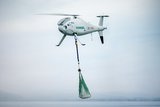Boeing-Insitu ScanEagle Logs 150,000 Service Hours in Iraq and Afghanistan
The ScanEagle unmanned aircraft system (UAS), a joint effort of The Boeing Company and its subsidiary Insitu Inc., last week flew its 150,000th hour in service with the U.S. Marine Expeditionary Forces, U.S. Navy, U.S. Special Operations Command, Australian Army and Canadian Forces.
ScanEagle has provided persistent in-theater intelligence, surveillance and reconnaissance (ISR) to the joint forces in Iraq and Afghanistan since 2004.
"Flying thousands of hours of ISR support in theater, month after month, requires a high degree of organization and teamwork," said Maj. Dan Griffiths, VMU-1 contracting officer technical representative, U.S. Marine Expeditionary Forces.
"The execution of that task falls on the shoulders of the ScanEagle field service representatives in theater. Day in and day out, they do whatever it takes to meet daily requirements."
Jim Havard, Boeing ISR Services Marine Corps program manager, added, "We've learned lessons from our extensive ScanEagle operations that have helped us refine the system into a mature ISR asset that is safe, dependable and satisfies the intelligence requirements of our soldiers and sailors.
These 150,000 service hours, along with numerous operational reports from our customers, confirm that ScanEagle has established itself as a critical capability for tactical ISR around the world."
The long-endurance, fully autonomous ScanEagle UAS carries inertially stabilized electro-optical and infrared cameras that allow the operator to track both stationary and moving targets. Capable of flying above 16,000 feet and loitering over the battlefield for more than 24 hours, the platform provides persistent low-altitude ISR.
ScanEagle is launched autonomously from a pneumatic SuperWedge catapult launcher and flies either preprogrammed or operator-initiated missions.
The Insitu-patented SkyHook system is used to retrieve the UAS, capturing it by way of a rope suspended from a 50-foot-high mast. The system makes ScanEagle runway-independent and minimizes its impact on shipboard operations, similar to a vertical-takeoff-and-landing vehicle.
More from Uncrewed Vehicles
-
Jammer resistant drone designs spark search for countermeasures
The Russia-Ukraine conflict has driven another stage of evolution for drones and the counter measures to defend against them.
-
![L3Harris launches Amorphous software for control of uncrewed platforms]()
L3Harris launches Amorphous software for control of uncrewed platforms
The new Amorphous software is a universal controller that would allow a single operator to control a swarm of “thousands” of uncrewed systems, from drones to underwater platforms.
-
ideaForge unveils new UAVs at Aero India 2025
India UAV supplier ideaForge has launched the Netra 5 and Switch V2 drones at Aero India 2025, boasting of enhanced endurance, AI-driven autonomy and improved operational capabilities.
-
![Shaping the future of defence: What 2025 holds for the global drone market]()
Shaping the future of defence: What 2025 holds for the global drone market
The UAV market is experiencing unprecedented growth, with innovations in technology and battlefield applications driving demand across military sectors. From the battlefields of Ukraine to NATO exercises and beyond, drones are transforming how wars are fought and supported.
-
![Maris-Tech confirms customers signing up for Jupiter Drones codec and AI-powered system]()
Maris-Tech confirms customers signing up for Jupiter Drones codec and AI-powered system
Launched at AUSA in October, the company’s multi-stream video codec is attempting to bring a new lease of life to drone technology through its AI accelerator.
-
![AUSA 2024: Quantum-Systems targets big 2025 with UAS developments]()
AUSA 2024: Quantum-Systems targets big 2025 with UAS developments
Quantum-Systems has been upgrading its UAS family, with new versions of the Vector, Reliant and Twister drones set for release throughout 2025.
























